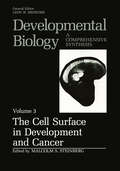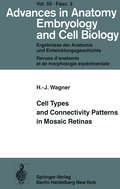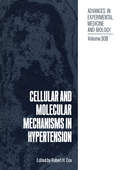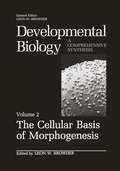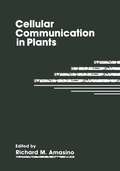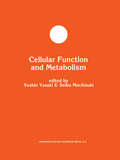- Table View
- List View
Cell Signalling in Prokaryotes and Lower Metazoa
by I. FairweatherCell signalling lies at the heart of many biological processes and currently is the focus of intense research interest. In multicellular organisms, it is central to how different types of cell communicate with each other and how they detect and respond to extracellular signals. Intercellular communication is vital to single-celled organisms as well, allowing them to respond to environmental cues and signals. To date, much of the understanding of signalling mechanisms has come from research on specific cell types (eg mouse lymphocyte and cardiomyocyte) or on organisms in which communication systems such as nervous and endocrine systems are well established. This volume therefore aims to 'fill the gap' by concentrating on 'simple organisms' where the elements of those signalling systems first evolved. Many of the groups covered contain important pathogens or parasites, and the potential for manipulating signalling pathways for therapeutic intervention will be highlighted.
The Cell Surface in Development and Cancer (Developmental Biology #3)
by Malcolm S. SteinbergThis series was established to create comprehensive treatises on specific topics in developmental biology. Such volumes serve a useful role in developmental biology, since it is a very diverse field that receives contributions from a wide variety of disciplines. This series is a meeting-ground for the various practi tioners of this science, facilitating an integration of heterogeneous information on specific topics. Each volume is intended to provide the conceptual basis for a comprehen sive understanding of its topic as well as an analysis of the key experiments upon which that understanding is based. The specialist in any aspect of devel opmental biology should understand the experimental background of the field and be able to place that body of information in context to ascertain where additional research would be fruitful. At that point, the creative process gener ates new experiments. This series is intended to be a vital link in that ongoing process of learning and discovery.
Cell to Cell Signals in Plants and Animals: Progress Report (Nato ASI Subseries H: #51)
by Volker Neuhoff John FriendSummarizing research progress achieved in 32 areas of cell biology covered in this series, this volume places special emphasis on the following topics: recognition in parasitic and symbiotic systems - the molecular biology and genetics of susceptibility and resistance of plants and animals to pathogens, parasites and symbionts - the cell to cell recognition and differentiation - the most challenging problems in developmental biology of plants and animals - the plasticity in cell to cell communication which plays a major role in cell differentiation and function.
Cell Types and Connectivity Patterns in Mosaic Retinas (Advances in Anatomy, Embryology and Cell Biology #55/3)
by Hans-Joachim WagnerIn many parts of vertebrate and invertebrate central nervous systems, groups of nerve or receptor cells can be found that are arranged and connected according to a precise, functionally defined pattern (Braitenberg, 1973; Santini, 1975; Strausfeld, 1976; Chan-Palay, 1977). In these cases, groups of cell bodies or synapses appear as basically similar configurations, which, however, are different in detail from each other. Such abstract patterns of connectivity are of a statistical nature and do not allow, in a given example, for the prediction of the localization or connections of a particular cell. "Wiring diagrams", therefore, can be obtained only from a multitude of individual observations. In contrast, in several sensory organs, concrete patterns occur that con sist of a regular, mosaic-like, and geometric arrangement of similar cell types. The constancy of such a mosaic allows predictions about certain units of the pattern on the basis of only a few exemplary observations. Typical examples are found in the visual system: In the compound eye of insects, each ommatidium contains a definite number of visual cells that are grouped around the optical axis in a hexogonal array (Kirsch feld, 1967); in the vertebrate retina, mosaics of geometrically arranged cones are found most frequently in lower vertebrates; they are common among teleosts. A number of studies have dealt with their phylogenetic significance and their functional role as adaptation to specific environments or modes of feeding.
Cell Volume and Signaling
by Peter Lauf Norma AdragnaIn front of you is the finished product of your work, the text of your contributions to the 2003 Dayton International Symposium on Cell Volume and Signal Transduction. As we all recall, this symposium brought together the Doyens of Cellular and Molecular Physiology as well as aspiring young investigators and students in this field. It became a memorable event in an illustrious series of International Symposia on Cell Volume and Signaling. This series, started by Professors Vladimir Strbák, Florian Lang and Monte Greer in Smolenice, Slovakia in 1997 and continued by Professors Rolf Kinne, Florian Lang and Frank Wehner in Berlin in 2000, is projected for 2005 in Copenhagen to be hosted by our colleague, Professor Else Hoffmann and her team. We dearly miss Monte Greer to whom this symposium was dedicated and addressed so eloquently by Vladimir Strbák in his Dedication to Monte. Monte and I became friends in Smolenice and had begun to discuss the 2003 meeting only a few days before his tragic accident in 2002. There are others who were not with us, and we missed them, too. We would not have been able to succeed in this event without the unflagging support of our higher administration at Wright State University, the NIDDKD of the National Institute of Health, and the Fuji Medical System (see Acknowledgments).
Cell Walls and Surfaces, Reproduction, Photosynthesis (Experimental Phycology #1)
by Wolfgang Wiessner David G. Robinson Richard C. StarrAlgae belong to the lower plants. They are not only favoured but also highly striking objects for studies on various areas of biology. The present volume of the new book series Experimental Phycology presents recent results of studies on the cell wall, reproduction, and photosynthesis of algae.
The Cello and the Nightingales: The Life of Beatrice Harrison (Canons)
by Beatrice Harrison Patricia Cleveland-PeckIn 1924, Beatrice Harrison broadcast a miracle to the world: a wild nightingale singing with her cello. Over a million people tuned in to hear the nightingale that night, and the BBC went on to broadcast their duet worldwide every spring until 1942. This transformed the public interest in nightingales – a species already in decline. If Beatrice’s duets with the nightingales touched a chord with the world, her own life proved to be as musical, free-spirited and inspiring. From her early years as a musical prodigy to recording with the most important composers of the day or playing for the wounded in the Second World War, Beatrice’s warmth and love for sharing music are as endearing now as they were to her original audiences.
Cells in Evolutionary Biology: Translating Genotypes into Phenotypes - Past, Present, Future (Evolutionary Cell Biology)
by Brian K. Hall Sally A. MoodyThis book is the first in a projected series on Evolutionary Cell Biology, the intent of which is to demonstrate the essential role of cellular mechanisms in transforming the genotype into the phenotype by transforming gene activity into evolutionary change in morphology. This book —Cells in Evolutionary Biology — evaluates the evolution of cells themselves and the role cells have been viewed to play as agents of change at other levels of biological organization. Chapters explore Darwin’s use of cells in his theory of evolution and how Weismann’s theory of the separation of germ plasm from body cells brought cells to center stage in understanding how acquired changes to cells within generations are not passed on to future generations. Chapter 7 of this book is freely available as a downloadable Open Access PDF under a Creative Commons Attribution-Non Commercial-No Derivatives 3.0 license. https://s3-us-west-2.amazonaws.com/tandfbis/rt-files/docs/Open+Access+Chapters/9781315155968_oachapter7.pdf
Cells in Evolutionary Biology: Translating Genotypes into Phenotypes - Past, Present, Future (Evolutionary Cell Biology)
by Brian K. Hall Sally A. MoodyThis book is the first in a projected series on Evolutionary Cell Biology, the intent of which is to demonstrate the essential role of cellular mechanisms in transforming the genotype into the phenotype by transforming gene activity into evolutionary change in morphology. This book —Cells in Evolutionary Biology — evaluates the evolution of cells themselves and the role cells have been viewed to play as agents of change at other levels of biological organization. Chapters explore Darwin’s use of cells in his theory of evolution and how Weismann’s theory of the separation of germ plasm from body cells brought cells to center stage in understanding how acquired changes to cells within generations are not passed on to future generations. Chapter 7 of this book is freely available as a downloadable Open Access PDF under a Creative Commons Attribution-Non Commercial-No Derivatives 3.0 license. https://s3-us-west-2.amazonaws.com/tandfbis/rt-files/docs/Open+Access+Chapters/9781315155968_oachapter7.pdf
Cells, Membranes, and Disease, Including Renal: Including Renal (pdf) (Methodological Surveys in Biochemistry and Analysis #17)
by E. Reid G. M. W. Cooke J. P. LuzioCellular Adhesion: Molecular Definition to Therapeutic Potential (pdf) (New Horizons in Therapeutics)
by Judy SchatzCellular and Molecular Aspects of Inflammation (New Horizons in Therapeutics)
by George Poste Stanley T. CrookeThe characterization of the cellular and molecular mechanisms that mediate inflammation provides a foundation that supports future studies that will de fine mechanisms more intimately. It encourages substantial optimism about the opportunities to understand the inflammatory process and to use that information to develop novel therapeutic approaches. Recent progress has defined the cells that mediate the inflammatory response, many of the inter cellular transmitters, the receptors, signal transduction processes and regula tory mechanisms. Thus, we now have the opportunity to understand inflammation in pharmacologic terms and to attack the key molecular targets to develop new therapeutics. Among the cells involved in the inflammatory response are the lympho cytes, neutrophils and endothelial cells. Maintenance of homeostasis, re sponse to proinflammatory stimuli and pathophysiologic responses are products of complex interactions between these and other elements of the immune systems. Each of these cells displays a variety of receptors to define the stimuli to which they respond. The receptors displayed that the signal transduction processes and cellular responses are regulated genetically and epigenetic ally . The critical role of membranes and particularly the phospho lipid components of the membranes is emphasized by recent studies.
Cellular and Molecular Bases of Biological Clocks: Models and Mechanisms for Circadian Timekeeping
by Leland N. EdmundsAn intriguing class of biological periodicity consists of rhythms with about 24-hour periods occurring at every level of eukaryotic organization. Progress is being made in understanding these rhythms. The six chapters of this work include a brief introduction to circadian (24-hour) rhythms, a survey of circadian organization at the cellular level, and a description of the important microorganisms that have served as experimental models for biochemical analysis. Also considered are relations between cell division cycles and circadian oscillators, as well as some general and theoretical aspects. Where appropriate, parallels are drawn to neuronal oscillators. This volume will introduce and critically appraise modern chronobiology; its extensive illustrations and comprehensive up-to-date bibliography will make it an authoritative reference.
Cellular and Molecular Biology of Intermediate Filaments
by R. D. Goldman P. M. SteinertResearch activity on intermediate filaments (IF) has increased dramatically over the past decade. For the most part, this surge of interest is due to their identification as ubiquitous constituents of the cytoskeleton and karyoskeleton (nuclear matrix) of eukaryotic cells and the fact that we know very little regarding their functions. In sharp contrast to the other major cytoskeletal systems, microfilaments and microtubules, IF exhibit a high degree of heterogeneity with regard to their protein subunit composition. Indeed, one can only marvel at the number of different IF polypeptides, their associated proteins (IFAP) and, consequently, the number of genes involved in encoding the multiple constituents of the various IF networks found in different cell types. The chapters in this book demonstrate how various experimental approaches involv ing cellular, molecular, biochemical, and immunological methods have been utilized to generate information regarding the structure and function of IF. To this end, we have gathered together chapters from experts in the major fields of IF research. In each chapter, the authors have combined reviews of the available scientific literature with their own ideas on current and future directions for IF research. The chapters have been divided into five major sections which are concerned with the subcellular organization of IF, the molecular structure of IF, the differential expression of IF genes, descriptions of associ ated proteins involved in the intracellular organization of IF, and finally an analysis of the changes seen in IF in pathological conditions.
Cellular and Molecular Biology of Mammary Cancer
by Daniel Medina, William Kidwell, Gloria Heppner and Elizabeth AndersonThe idea for this book arose during the 1985 Gordon Conference on "Mammary Gland Biology". New developments in the methodology of cell biology and the explosive growth of molecular biology had begun to impact upon our understanding of mammary gland growth and function. It seemed a propitious time for summarizing the current status of knowledge of the cell and molecular biology of mammary cancer and for attempting to outline future areas of concern and interest. The reviews presented here were completed by the Fall of 1986. Although new insights will surely continue to emerge, it is hoped that the material in this volume will form not only a current update but a basic core of information for future experiments. We have not attempted to cover all areas of mammary gland transformation. Those areas where recent detailed reviews are already available have been omitted. Also, the areas of normal gland development, cell ultrastructure, hormone responsiveness, chemotherapy and clinical aspects of mammary cancer have not been included. Instead, we have selected those areas where the development of new methodology, reagents and results have led to new ideas about mammary gland function and development as they are related to neoplasia.
Cellular and Molecular Biology of Neuronal Development
by Ira BlackA central problem in neurobiology concerns mechanisms that generate the pro found diversity and specificity of the nervous system. What is the substance of diversification and specificity at the molecular, cellular, and systems levels? 4 How, for example, do 1011 neurons each form approximately 10 interconnec tions, allowing normal physiological function? How does disruption of these processes result in human disease? These proceedings represent the efforts of molecular biologists, embryologists, neurobiologists, and clinicians to approach these issues. in this volume are grouped by subject to present the varieties The chapters of methods used to approach each individual area. Section I deals with embry ogenesis and morphogenesis of the nervous system. In Chapter 3, Weston and co-workers describe the use of monoclonal antibodies that recognize specific neuronal epitopes (including specific gangliosides) for the purpose of defining heterogeneity in the neural crest, an important model system. Immunocyto chemical analysis reveals the existence of distinct sUbpopulations within the crest at extremely early stages; cells express neuronal or glial binding patterns at the time of migration. Consequently, interactions with the environment may select for predetermined populations. Le Douarin reaches similar conclusions in Chapter 1 by analyzing migratory pathways and developmental potentials in crest of quail-
Cellular and Molecular Control of Neuronal Migration (Advances in Experimental Medicine and Biology #800)
by Laurent Nguyen Simon HippenmeyerCellular and Molecular Control of Neuronal Migration provides an up-to-date collection of reviews on the molecular and cellular principles of neuronal migration in the mammalian brain. Over the last decades a rich catalogue of signaling molecules controlling neuronal migration has been compiled, and within this book an international panel of experts provides up-to-date discussions of the state of knowledge how these distinct signaling pathways regulate various aspects of neuronal migration. This book introduces the reader to the latest discoveries and concepts of neuronal migration enabled through the application of most sophisticated methods and cutting edge experimental approaches.Cellular and Molecular Control of Neuronal Migration also provides an update on the underlying cellular and molecular basis of neurodevelopmental migration disorders in human patients for all interested neuroscientists and clinicians.
Cellular and Molecular Mechanisms in Hypertension (Advances in Experimental Medicine and Biology #308)
by Robert H. CoxHypertension is recognized to be one of the major risk factors for the development of peripheral vascular disease. The last decade has witnessed several major advances in therapy for hypertension, including the development of angiotensin-converting enzyme inhibitors and calcium channel blockers. These compounds have greatly improved the ability to control blood pressure and to reduce the impact of this risk factor on morbidity and mortality. In spite of these advances, cardiovascular disease remains a major health problem in most modern industrialized countries with related deaths exceeding those from all other causes combined. In contrast to these advances in therapy, our understanding of the basic mechanisms responsible for the pathogenesis of hypertension remains incomplete. Recent studies have produced new insights into the nature of the regulation of muscle contraction in both heart and blood vessels as well as the changes in muscle function that occur in hypertension. However, the effects of antihypertensive therapy, both in terms of restoring normal function and in producing reversal of hypertension-associated changes, has not been as thoroughly studied, especially in the vasculature. Studies in the heart suggest that the efficacy of different therapeutic agents in restoring normal function and reversing hypertensive changes vary substantially with the mechanism of action of the therapeutic agent. It has also been recently determined that some therapeutic agents produce adverse effects on plasma lipid profiles, which could lead to the secondary acceleration of the atherosclerotic process, while at the same time normalizing blood pressure.
Cellular and Molecular Methods in Neuroscience Research
by Adalberto Merighi C. Cuello Giorgio CarmignotoThere are numerous books on cellular and molecular protocols for general use in cell biology but very few are exclusively devoted to neurobiology. This book fills this gap and explains in a clear and consistent manner, some of the more commonly used protocols in neuroscience research. Each chapter is written by either the person who invented the procedure or an expert in the field. The format is uniform: "Overview," "Background," "Protocols," and "results and discussion." Each protocol begins with the principle of the technique, studies in cell culture, materials and reagents, and, lastly, step-by-step outline of the procedure itself. This highly practical book is also well illustrated (with 17 four color plates) to make the concepts and procedures easy to understand and perform.
The Cellular Basis of Morphogenesis (Developmental Biology #2)
by Leon W. BrowderThis series was established to create comprehensive treatises on specialized topics in developmental biology. Such volumes are especially vital in develop mental biology, since it is a very diverse field that receives contributions from a wide variety of disciplines. This series is a meeting-ground for the various practitioners of this science, facilitating an integration of heterogeneous infor mation on. specific topics. Each volume is intended to provide the conceptual basis for a comprehen sive understanding of its topic as well as an analysis of the key experiments upon which that understanding is based. The specialist in any aspect of devel opmental biology should understand the experimental background of the field and be able to place that body of information in context to ascertain where additional research would be fruitful. At that point, the creative process takes over, and new experiments are designed. This series is intended to be a vital link in that ongoing process of learning and discovery. If it facilitates schol arship, it will serve an important function.
Cellular Function and Metabolism (Developments in Molecular and Cellular Biochemistry #9)
by Yoshio Yazaki Seibu MochizukiA variety of metabolic processes are known to be intimately involved in the maintenance of cellular structure and function. It has also become clear that metabolic events involved in the synthesis and hydrolysis of ATP as well as for the synthesis of proteins and phospholipids are essential for cellular health. The regulation of cell function is generally achieved through participation of a wide variety of hormones and different signal transduction mechanisms for the activation/deactivation of some specific metabolic processes. In this regard cyclic AMP and calcium seem to play a crucial role. Various hormones are also known to affect the genetic machinery of all the cell; however, the exact signals for genetic control of cellular function are not well defined. In particular, the sequence of events concerned with remodelling of different types of cells under various pathological situations is poorly understood. In this book we have therefore dealt with some of these issues from biochemical, molecular biological, physiological, and pharmacological viewpoints. Special emphasis has been laid on understanding heart function and metabolism in health and disease in general, and cardiac hypertrophy, heart failure, and ischemic heart disease in particular. It is hoped that this multidisciplinary information will be of value to basic scientists and clinical investigators.
Cellular Interactions (Encyclopedia of Plant Physiology #17)
by H. F. Linskens J. Heslop-HarrisonH. F. LINSKENS and J. HESLOP-HARRISON The chapters of this volume deal with intercellular interaction phenomena in plants. Collectively they provide a broad conspectus of a highly active, if greatly fragmented, research field. Certain limitations have been imposed on the subject matter, the most impor tant being the exclusion of long-range interactions within the plant body. It is true that pervasive hormonal control systems cannot readily be demarcated from controls mediated by pheromones or information-carrying molecules with more limited spheres of action, but consideration is given in this volume to the main classes of plant hormones and their functions only incidentally, since these are treated adequately in other volumes of this Encyclopedia series (V - ume 9-11) and in numerous other texts and reviews. Similarly, certain other effects, such as those associated with nutrients and ions, are not considered in any detail. Furthermore, we have excluded intracellular interactions, and also consideration of transport phenomena, which are treated in detail in Vol ume 3 of this Series. Other aspects of inter-cellular interaction, such as cell surface phenomena and implications of lectin-carbohydrate interactions, and plant-virus inter-relationships, are treated in other sections of this Encyclopedia (Volumes 13B and 14B, respectively). In the volume on physiological plant pathology (Volume 4 of this series) special attention has been given to host pathogen interaction. These aspects of our subject will therefore be excluded in the present treatise.
Cellular Mechanisms of Sensory Processing: The Somatosensory System (Nato ASI Subseries H: #79)
by Laszlo UrbanThe research field of somatosensory processing in mammals has experienced revolutionary changes in recent years. Accumulation of basic and clinical data has greatly accelerated, and new phenomena have emerged. With the aid of new, refined methods, molecular and cellular changes have been described, underlying the signal transduction-transmission between the internal/external environment and the central nervous system have been described. The discovery of the interaction between the nervous and the immune system has, for example changed our view on the development of inflammatory diseases, while the cloning of genes encoding different trophic factors has boosted studies revealing profound changes in the regeneration of neurons, and induction of changes in phenotype. The study of the pre-and postsynaptic modulation of transmitter release, and the examination of the combined effects of amino acid and peptide transmitters has become recently possible by using cultured cell lines and in vitro techniques. Although it is in embryonic state, computational properties of single DRG cells under normal and pathological conditions are being investigated. Results soon or later will have a great impact on pain research and consequently ultimately in clinical pain management. This brief introduction indicates how our knowledge of the somatosensory system has increased dramatically recently. However, many investigators cultivate only a very specific field in the growing area of somatosensory research and find it difficult to integrate a more universal knowledge of their work.

